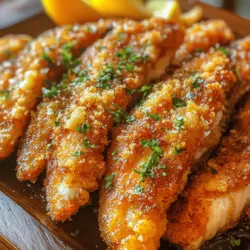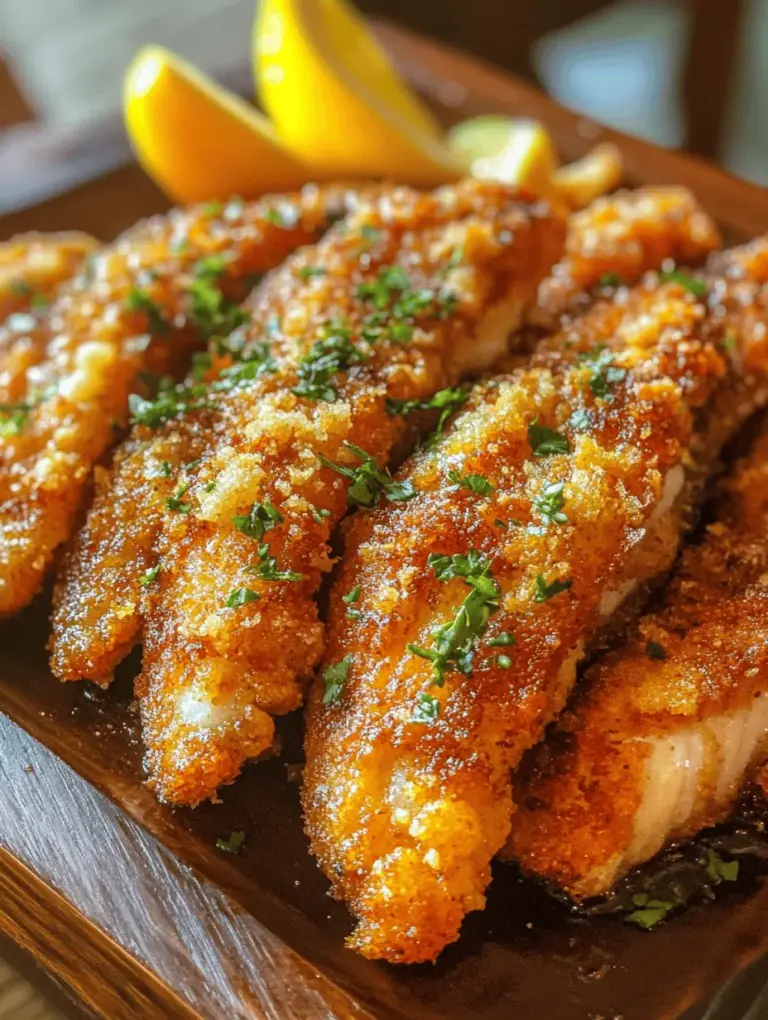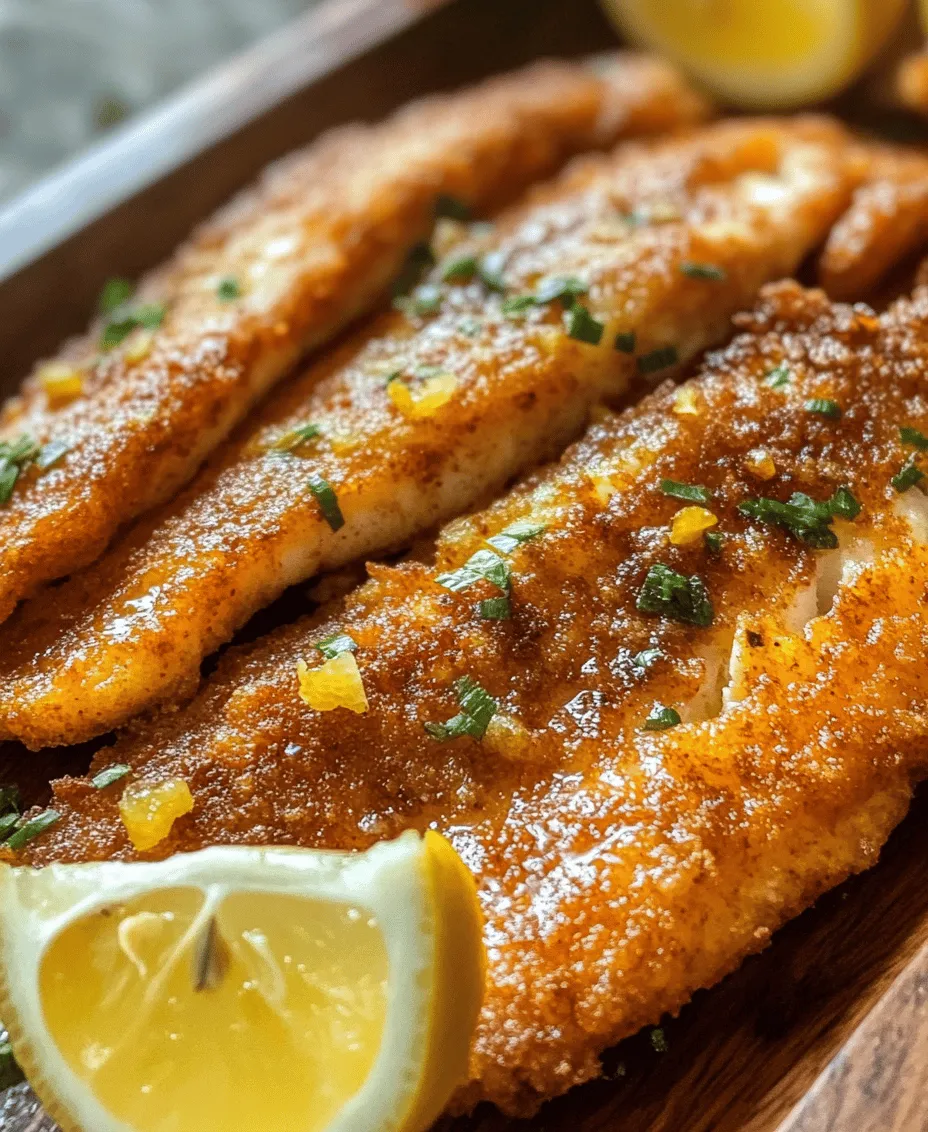Introduction
Southern cuisine is a vibrant tapestry woven from various cultural influences, ranging from Native American traditions to African and European flavors. This rich culinary heritage is characterized by its bold flavors, unique cooking techniques, and an undeniable sense of comfort. Among the many beloved dishes that emerge from this tradition, fried fish holds a special place in the hearts and homes of Southern families. The irresistible crunch of golden-brown batter encasing tender fish is a hallmark of Southern cooking, making it a staple at family gatherings, fish fries, and Sunday dinners.
Fried fish is not just a meal; it’s an experience that brings people together. In Southern households, the aroma of fish sizzling in hot oil often fills the air, evoking memories of shared meals and laughter. The beauty of this dish lies not only in its taste but also in its versatility. While catfish is the traditional choice, you can opt for other white fish varieties, depending on your preference.
In this article, we will delve into the secrets of making authentic Southern-style fried fish. We will explore the key ingredients that contribute to its mouthwatering flavor and provide detailed step-by-step instructions to ensure your fried fish turns out perfectly every time. Whether you are a Southern native or a curious food lover, this recipe will guide you through the process of creating a dish that embodies the spirit of Southern hospitality.
Understanding the Ingredients
To create the best Southern fried fish, it is essential to understand the ingredients that make this dish truly special. Each component plays a crucial role in achieving the ultimate flavor and texture that Southern fried fish is known for.
Fresh Catfish or Preferred White Fish
At the heart of this recipe is the fish itself. Traditionally, catfish is the fish of choice for Southern frying due to its mild flavor and firm texture, which holds up well during frying. However, other white fish varieties, such as tilapia, cod, or flounder, can also be used depending on your taste preferences. When selecting your fish, freshness is key. Always opt for fish that appears moist and has a clean, ocean-like scent. If you’re purchasing from a market, ask to see the catch of the day or choose fillets that have been freshly cut.
The Role of Buttermilk
Buttermilk is a quintessential ingredient in Southern cooking, particularly when it comes to marinating fish. This tangy dairy product is not merely a flavor enhancer; it serves a critical function in tenderizing the fish, making it more succulent and juicy. The acidity of buttermilk breaks down the proteins in the fish, resulting in a tender texture that is a delight to bite into.
Additionally, buttermilk imparts a subtle richness and depth of flavor that enhances the overall dish. If you prefer a bit of heat, consider adding a splash of hot sauce to the buttermilk marinade for an extra kick.
The Significance of Spices
Spices are where the magic happens in Southern fried fish, elevating the dish from simple to extraordinary. The combination of garlic powder, onion powder, and paprika creates a flavor profile that is both robust and aromatic.
– Garlic Powder: Adds a savory, earthy flavor that complements the natural taste of the fish.
– Onion Powder: Introduces a hint of sweetness and depth, enhancing the overall flavor without overwhelming the dish.
– Paprika: Not only does it contribute a beautiful color to the crust, but it also adds a mild smokiness that perfectly balances the other spices.
These spices can be adjusted based on personal preference, allowing you to customize the flavor of your fried fish to suit your palate.
Choosing the Right Oil for Frying
The choice of oil is pivotal in achieving the perfect fry. For Southern fried fish, oils with a high smoke point are best, as they can withstand the high temperatures required for frying without burning. Common choices include peanut oil, canola oil, or vegetable oil. Peanut oil, in particular, is favored for its mild flavor and ability to impart a subtle nuttiness to the fish. Regardless of the oil you choose, ensure that it is fresh and suitable for frying to achieve that beautifully crispy exterior.
Marinating the Fish
Now that we’ve gathered our ingredients, it’s time to focus on the critical marination process. This step is essential for infusing the fish with flavor and ensuring a tender texture.
The Marination Process
Begin by rinsing your fish fillets under cold water and patting them dry with paper towels. This step is crucial as it removes any residual moisture, allowing the marinade to adhere better. In a large bowl, combine the buttermilk with your chosen spices—garlic powder, onion powder, paprika, and a pinch of salt and pepper. For those who enjoy a bit of spice, feel free to add a few dashes of your favorite hot sauce to the mixture.
Once your marinade is ready, immerse the fish fillets in the buttermilk mixture, ensuring they are completely coated. Cover the bowl with plastic wrap or a lid, then place it in the refrigerator. Marinating the fish for at least 30 minutes to 1 hour is recommended, as this allows the flavors to penetrate the fish while the buttermilk tenderizes it. For optimal flavor absorption, marinating overnight is an excellent option if time permits.
Optional Hot Sauce
As mentioned, if you’re looking to add an extra layer of flavor and heat, incorporating hot sauce into the buttermilk is a fantastic idea. The heat from the sauce will balance beautifully with the richness of the fish, making every bite an explosion of flavor. Be sure to adjust the amount based on your tolerance for spice—start with a small amount and increase it to your liking.
Preparing the Breading
While the fish marinates, it’s time to prepare the breading, which is essential for achieving that coveted crispy crust. The breading is what will give your fried fish its signature crunch and flavor.
Creating the Breading Mixture
For the breading, you will need the following components:
– All-Purpose Flour: This will serve as the base for your breading and is crucial for creating that golden crust.
– Cornmeal: A Southern staple, cornmeal adds texture and a hint of sweetness to the breading, enhancing the overall flavor of the fried fish.
– Seasonings: In addition to the spices used in the marinade, you can add a pinch of cayenne pepper for heat, or additional paprika for color.
In a large shallow dish, combine equal parts all-purpose flour and cornmeal. A standard ratio is 1 cup of flour to 1 cup of cornmeal, but feel free to adjust based on your preference for texture. Add in your seasonings—this is where you can get creative. Mixing in a bit of salt, pepper, and additional spices will ensure that the breading has its own unique flavor profile that complements the fish.
Once the breading mixture is prepared, it’s time to coat the marinated fish. Remove the fish fillets from the refrigerator and let any excess marinade drip off. Dredge each fillet in the breading mixture, making sure to coat all sides evenly. This step is crucial, as an even coating will result in a uniform crust when fried.
By following these steps, you are well on your way to mastering the art of Southern fried fish. In the next part of this article, we will detail the frying process and share some expert tips for achieving that perfect golden brown exterior while keeping the fish moist and tender inside. Stay tuned as we embark on this flavorful journey through one of the South’s most cherished dishes.
The Roles of Flour and Cornmeal in Achieving the Desired Texture
When it comes to achieving that perfect crispy exterior for your Southern fried fish, the choice of coating is crucial. The combination of flour and cornmeal plays a significant role in creating the desired texture. All-purpose flour provides a light, tender base that adheres well to the fish, while cornmeal adds a distinctive crunch and a slightly nutty flavor that elevates the dish. The two work in harmony to create a crust that is not only crispy but also has a delightful contrast in texture.
Using a 50-50 blend of flour and cornmeal is a popular ratio, as it gives you the best of both worlds. The flour’s gluten content helps the coating stick, while the cornmeal’s coarseness adds that signature crunch. For those looking to experiment, consider using fine cornmeal for a smoother finish or stone-ground cornmeal for a heartier texture.
Importance of Evenly Blending Spices for a Balanced Flavor Profile
Another essential element in achieving delicious Southern fried fish is the seasoning. The flavor of the fish comes primarily from the spices you incorporate into your breading mixture. A well-balanced blend of spices can transform a simple dish into something extraordinary. Common spices to consider include paprika, garlic powder, onion powder, cayenne pepper, and black pepper, along with salt to enhance the overall taste.
To ensure a consistent flavor throughout the dish, it’s vital to blend the spices evenly before adding them to the flour and cornmeal mixture. This step prevents clumps of individual spices from forming, which can lead to uneven seasoning. A good practice is to whisk the spices together in a bowl before mixing them with the flour and cornmeal. This way, each piece of fish will be evenly coated with that signature Southern flavor.
Dredging the Fish
Detailed Instructions on How to Properly Coat the Fish
Once your fish fillets are ready and your breading mixture is prepared, it’s time to dredge the fish. Dredging is the process of coating the fish in a mixture of buttermilk and the flour-cornmeal blend. Start by placing your fish fillets in a shallow dish or bowl. Pour buttermilk over the fillets, ensuring they are completely submerged. Let them soak for about 15 to 20 minutes. This step not only adds flavor but also helps the breading adhere better.
After soaking, take each fillet and allow any excess buttermilk to drip off. This is a crucial step; if too much buttermilk clings to the fish, it can result in a soggy coating. Next, transfer the fillets to the flour and cornmeal mixture. Gently press the mixture onto the fish to ensure an even coating. Flip the fillets over and repeat the process, making sure each piece is thoroughly coated on both sides.
Tips for Ensuring an Even and Thorough Coating of the Breading Mixture
To achieve that perfect crust, consider using the “dredge, dip, and dredge” method. After the initial dredging in the flour-cornmeal mixture, dip the coated fillet back into the buttermilk briefly before returning it to the dry mixture for a second coat. This double-dredging technique creates a thicker, crunchier crust that holds up beautifully during frying.
Always work in small batches to avoid overcrowding the dredging station. This will help maintain the integrity of the coating and make the process more manageable.
Importance of Letting Excess Buttermilk Drip Off Before Dredging
As mentioned earlier, allowing the excess buttermilk to drip off is essential for achieving optimal results. If you skip this step, you risk ending up with a heavy, soggy coating that won’t fry properly. Aim for a light coating that clings just enough to adhere to the fish. A thin layer of buttermilk is all you need to create a perfect bond with the flour and cornmeal mixture.
Frying the Fish
Instructions for Heating the Oil to the Correct Temperature
Once your fish is properly coated, it’s time to heat the oil. Choose a heavy-bottomed skillet or deep fryer for frying, as they retain heat well and ensure even cooking. Pour in enough oil to cover the bottom of the pan by about half an inch. You can use vegetable oil, peanut oil, or canola oil, which all have high smoke points and are ideal for frying.
Heat the oil over medium-high heat until it reaches approximately 350°F (175°C). To check if the oil is hot enough, you can drop a small piece of the breading mixture into the oil; if it sizzles immediately, you’re ready to fry. Alternatively, using a thermometer will give you a precise reading, ensuring you achieve that perfect frying temperature.
Importance of Temperature Control in Frying for Even Cooking
Keeping the oil at a consistent temperature is vital for achieving evenly cooked fish. If the oil is too hot, the outside can burn before the inside is fully cooked. If it’s too low, the fish will absorb excess oil and become greasy. Aim to maintain the oil temperature between 325°F and 350°F during frying. You may need to adjust the heat as you add the fish to the oil, as the temperature can drop when the colder fish is introduced.
Techniques for Safely Frying the Fish in Batches
Fry the fish in small batches to avoid overcrowding the pan, which can lower the oil temperature and lead to uneven cooking. Carefully place the fillets in the hot oil, ensuring they are not touching. Fry for about 4 to 5 minutes per side or until the coating turns golden brown and crispy. Use tongs or a slotted spoon to flip the fish gently, taking care not to disturb the coating.
Visual Indicators for Knowing When the Fish is Perfectly Cooked
You’ll know the fish is perfectly cooked when the coating is a deep golden brown and the fish flakes easily with a fork. If you have a food thermometer, the internal temperature of the fish should reach 145°F (63°C). If you don’t have a thermometer, the flakiness test is a reliable method.
Draining and Serving the Fish
Tips on How to Properly Drain Excess Oil from the Fried Fish
Once the fish is cooked, it’s crucial to drain it properly to avoid sogginess. Use a slotted spoon to carefully remove the fillets from the hot oil and transfer them to a plate lined with paper towels. This will absorb any excess oil and keep your fried fish crispy. Allow the fish to drain for a few minutes before serving.
Suggestions for Serving, Including the Use of Lemon Wedges
Serve your Southern fried fish hot, garnished with lemon wedges for a refreshing burst of acidity that complements the rich flavors of the fried coating. Squeezing fresh lemon juice over the fish just before eating enhances the dish and balances the flavors beautifully.
Optional Side Dish Recommendations to Complement the Meal, Such as Coleslaw or Hushpuppies
To round out your Southern fried fish meal, consider pairing it with classic side dishes. Coleslaw adds a crunchy, refreshing contrast to the crispy fish, while hushpuppies provide a delightful sweetness. Other great options include fried green tomatoes, baked beans, or seasoned fries. Each of these sides brings its own unique flavor and texture, creating a well-rounded meal that embodies Southern hospitality.
Conclusion
Preparing Southern fried fish is not only straightforward but also immensely satisfying. The process of dredging, frying, and serving this classic dish allows you to connect with the rich culinary traditions of the South. The combination of perfectly seasoned fish, a crispy coating, and delightful side dishes creates a meal that is sure to impress family and friends alike.
Embracing Southern cooking traditions opens the door to a world of flavors, techniques, and cherished memories. Cooking is an opportunity to share love and creativity in the kitchen, and there’s nothing quite like gathering around the table to enjoy a homemade feast. So, roll up your sleeves, gather your ingredients, and dive into the joy of preparing Southern fried fish—your taste buds will thank you!



